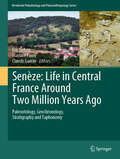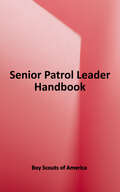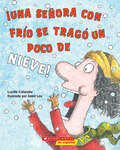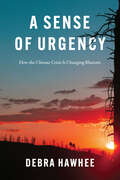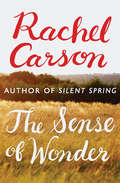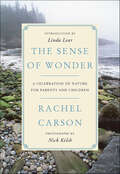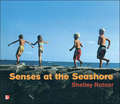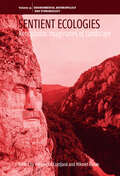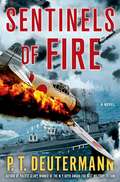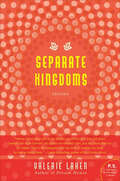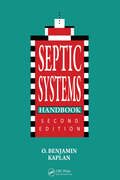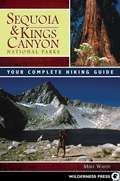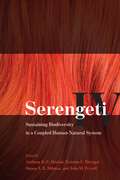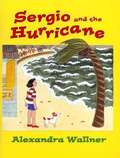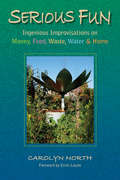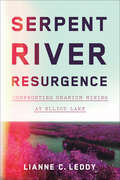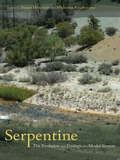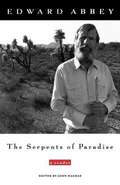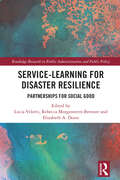- Table View
- List View
Senèze: Paleontology, Geochronology, Stratigraphy and Taphonomy (Vertebrate Paleobiology and Paleoanthropology)
by Eric Delson Martine Faure Claude GuérinThe paleontological site of Senèze (Haute Loire, central France) was discovered in 1892 inside a volcanic crater. For over 40 years, local peasant Pierre Philis collected fossils and sold them to French and Swiss museums. The site became world-famous for its well-preserved skeletons of ungulates and carnivores, as well as rare but well-preserved remains of primates and other mammals. It is considered the reference fauna for the late Villafranchian and MNQ 18 biochronological units of European mammalian evolution, but the lack of provenance data made modern research difficult. From 2000-2006, the multidisciplinary Franco-American Senèze Research Project undertook five seasons of major fieldwork, with the goals of clarifying the age, stratigraphy and taphonomy of Senèze, as well as finding additional remains, especially of the less well-known taxa. In this volume, following a history of study and summary of the new fieldwork, four geological chapters consider field methods, stratigraphy, volcanology and dating. Combining argon-argon ages and paleomagnetic calibration, the newly recovered fossils are shown to date between 2.20 and 2.08 Ma, with concentrations ca. 2.20-2.18 and 2.10-2.08 Ma, significantly older than previously thought. Chapters on palynology, ichthyology and ornithology are followed by eight chapters on the fossil mammals. The chapter on biochronology places Senèze among other sites at the start of MNQ 18, which is estimated to end ca. 1.7 Ma. Of some 2200 specimens known from the site, over half are cervids, with bovids, rhinocerotids and equids far behind. According to data from palynology and the habitat preferences of the more common mammals, the paleoenvironment around the Senèze maar would have included forest, woodland and grassland, perhaps in a warmer and moister climate than today. Taphonomic studies revealed that bones often rested a long time under water, lacked any indication of carnivore attack and often displayed pathologies in their joints. It is likely that most of the associated skeletons were preserved undisturbed after large mammals fell into the paleolake and drowned without being able to climb out. This book responds to the long-held desire of later Cenozoic paleontologists to see a modern study of a site recognized worldwide as a biochronologic reference for the Plio-Pleistocene. Our study required renewed fieldwork using up to date techniques of topography, sedimentology, stratigraphy, geochronology and taphonomy. The systematic paleontology chapters are based on re-study of the entire body of Senèze fossils collected during more than a century of research. The volume will be of interest to paleontologists, especially those concerned with the evolution of the European fauna and with the taxa studied, as well as with paleoenvironmental reconstruction and biogeography. It will also be of value to mammalogists interested in analyses of near-modern taxa and to paleoanthropologists, archaeologists and taphonomists interested in the methods utilized and the role of Senèze as a comparative standard for a site of this age without human intervention. It will surely be an essential reference for all those who want to know more about Life in Central France Around Two Million Years Ago.
Senior Patrol Leader Handbook
by Boy Scouts of AmericaThe Senior Patrol Leaders Handbook is a youth troop leader's go-to resource for effective leadership. This handbook helps leaders build troop spirit, organize meetings, and lead Scouts beyond the meeting room.
¡Una señora con frío se tragó un poco de nieve! (There Was a Cold Lady Who Swallowed Some Snow!)
by Lucille ColandroHere's the newest (and coldest) twist on the familiar tale of There Was an Old Lady Who Swallowed a Fly, now in board book!¡Esta vez, la señora con frío se traga todo, desde la nieve hasta una pipa, carbón, un sombrero y más! Esta animada versión, con un texto alegre y rimado e ilustraciones divertidas, atraerá a los lectores jóvenes en cada vuelta de página. ¡Y esta vez, hay una sorpresa al final que ningún lector podrá adivinar!This time, this cold lady is swallowing everything from snow to a pipe, some coal, a hat, and more! With rollicking, rhyming text and funny illustrations, this lively version will appeal to young readers with every turn of the page. And this time, there's a surprise at the end no reader will be able to guess!
A Sense of the Future: Essays in Natural Philosophy
by Jacob BronowskiScientist, humanist, optimist, the late Jacob Bronowski in these essays explores the singularity of humankind, the essence of science, and the idea of a life force antecedent to nature.
A Sense of Urgency: How the Climate Crisis Is Changing Rhetoric
by Debra HawheeA study of how the climate crisis is changing human communication from a celebrated rhetorician. Why is it difficult to talk about climate change? Debra Hawhee argues that contemporary rhetoric relies on classical assumptions about humanity and history that cannot conceive of the present crisis. How do we talk about an unprecedented future or represent planetary interests without privileging our own species? A Sense of Urgency explores four emerging answers, their sheer novelty a record of both the devastation and possible futures of climate change. In developing the arts of magnitude, presence, witness, and feeling, A Sense of Urgency invites us to imagine new ways of thinking with our imperiled planet.
The Sense of Wonder
by Rachel CarsonAn inspiring meditation by one of the best nature writers of the twentieth century, richly illustrated by lush, color photography Rachel Carson shares her prescription for developing a lifelong respect for nature in this deeply personal essay, lavishly expanded and paced by Nick Kelsh's vibrant photography in this posthumously published edition. Using her personal adventures with her young nephew Roger as examples, Carson urges parents to let their children's natural excitement thrive as together they discover the wonders that lie outdoors, from the scuttling of a crab across the cool night sand to a spongy carpet of lichen in a forest. Originally published as a magazine piece, this essay showcases Carson's core belief that a childlike excitement for beauty, for the new and unknown, and for the process of discovery is a gift to be nurtured--a gift that will sustain humanity and the health of the planet on which it depends. This ebook features an illustrated biography of Rachel Carson including rare photos and never-before-seen documents from the Beinecke Rare Book and Manuscript Library at Yale University.
The Sense of Wonder: A Celebration of Nature for Parents and Children
by Rachel CarsonFirst published a half-century ago, Rachel Carson's award-winning The Sense of Wonder remains the classic guide to introducing children to the marvels of natureIn 1955, acclaimed conservationist Rachel Carson—author of Silent Spring—began work on an essay that she would come to consider one of her life’s most important projects. Her grandnephew, Roger Christie, had visited Carson that summer at her cottage in Maine, and together they had wandered the surrounding woods and tide pools. Teaching Roger about the natural wonders around them, Carson began to see them anew herself, and wanted to relate that same magical feeling to others who might hope to introduce a child to the beauty of nature. “If a child is to keep alive his inborn sense of wonder,” writes Carson, “he needs the companionship of at least one adult who can share it, rediscovering with him the joy, excitement and mystery of the world we live in.”Now available in paperback, The Sense of Wonder is a timeless volume that will be passed on from generation to generation, as treasured as the memory of an early-morning walk when the song of a whippoorwill was heard as if for the first time. Featuring serene color photographs from renowned photographer Nick Kelsh, “this beautifully illustrated edition makes a fine gift for new and prospective mothers and fathers” (Gregory McNamee), and helps us all to tap into the extraordinary power of the natural world.
A Sense of Wonder Towards Nature: Healing the Planet through Belonging
by Haydn WashingtonEnvironmental scientist and writer Haydn Washington argues that we will not solve the environmental crisis unless we change our worldview and ethics, and to do so we must rejuvenate our sense of wonder at nature. This book focuses on humanity’s relation with nature, and the sense of wonder and belonging common to indigenous cultures and children everywhere. Drawing on events in the author’s own four decades working to protect wild places, and the current literature on wonder, it examines what a sense of wonder is, what it has been called in different cultures, and our high points of wonder at nature. It also looks at the ‘Great Divide’ in worldview between anthropocentrism and ecocentrism, and considers the problem of anthropocentric theory in academia, arguing that the focus should instead be on harmony with nature. The book concludes with an examination of why wonder has become buried in Western society and considers ways in which it can be revived, including rituals and education. It also considers how wonder helps humanity to become ‘whole’. The final chapter presents the road back to wonder and how wonder towards nature can be restored in Western society. This book will be of great interest to environmental scientists, conservation biologists, environmental philosophers and ecological ethicists, as well as environmentalists, educators, eco-psychologists, and students looking at sustainability, deep ecology, and environmental philosophy and ethics.
Senses at the Seashore (Shelley Rotner's Early Childhood Library)
by Shelley RotnerA child shares the sights, sounds, smells, touches, and tastes of a day at the seashore.
Sentient Ecologies: Xenophobic Imaginaries of Landscape (Environmental Anthropology and Ethnobiology #31)
by Alexandra Coțofană Hikmet KuranEmploying methodological perspectives from the fields of political geography, environmental studies, anthropology, and their cognate disciplines, this volume explores alternative logics of sentient landscapes as racist, xenophobic, and right-wing. While the field of sentient landscapes has gained critical attention, the literature rarely seems to question the intentionality of sentient landscapes, which are often romanticized as pure, good, and just, and perceived as protectors of those who are powerless, indigenous, and colonized. The book takes a new stance on sentient landscapes with the intention of dispelling the denial of “coevalness” represented by their scholarly romanticization.
Sentinels of Fire: A Novel
by P. T. DeutermannP. T. Deutermann's World War II navy series began with the award-winning Pacific Glory, followed by the brilliantly reviewed Ghosts of Bungo Suido. His new novel Sentinels of Fire tells the tale of a lone destroyer, the USS Malloy, part of the Allied invasion forces attacking the island of Okinawa and the Japanese home islands. By the spring of 1945, the once mighty Japanese fleet has been virtually destroyed, leaving Japan open to invasion. The Japanese react by dispatching hundreds of suicide bombers against the Allied fleet surrounding Okinawa. By mid-May, the Allied fleet is losing a major ship a day to murderous swarms of kamikazes streaming out of Formosa and southern Japan. The radar picket line is the first defense and early warning against these hellish formations, but the Japanese direct special attention to these lone destroyers stationed north and west of Okinawa. One destroyer, the USS Malloy, faces an even more pressing issue when her Executive Officer Connie Miles begins to realize that the ship's much-admired Captain Pudge Tallmadge is losing his mind under the relentless pressure of the attacks. Set against the blazing gun battles created by the last desperate offensive of the Japanese, Executive Officer Miles and the ship's officers grapple with the consequences of losing their skipper's guidance--and perhaps the ship itself and everyone on board Vividly authentic, historically accurate, and emotionally compelling, Sentinels of Fire is military adventure at its best, by an author whose career as a Navy captain informs every page.
Separate Kingdoms: Stories
by Valerie LakenFrom Valerie Laken, the Pushcart Prize–winning author of Dream House, comes a powerful collection of short stories charting the divisions and collisions between cultures and nations, families and outsiders, and partners and misfits searching for love. Set in Russia and the United States, these are boldly innovative stories—tales of fractured, misplaced characters moving beyond the borders of their isolation and reaching for the connections that will make them whole.A family, shaken by an industrial accident, is divided, its members isolated in their home and only able to understand one another from their separate rooms. A young gay couple travels to Russia to meet the child they're desperately trying to adopt, but the experience reveals an emotional divide between the parents-to-be. A recent amputee removes herself from her body to keep her husband at bay. And the idyllic village life of a blind Russian boy is disrupted by an American dentist and the wonders of racy Western magazines. Separate Kingdoms is a rich and satisfying collection that traverses the distances between people and places in each marvelously rendered story.
Septic Systems Handbook
by O. Benjamin KaplanSeptic Systems Handbook, Second Edition covers all aspects of such topics as septic tanks, perk tests, leachlines, and onsite disposal technologies. This handy reference is filled with numerous practical tips for troubleshooting and creative problem solving. The many appendices offer valuable information, including dealing effectively with bureaucr
Sequences
by Leslie Norris[from the back cover] "LESLIE NORRIS'S eleventh collection of poetry, Sequences, brings together some of his strongest and most eloquent recent work. Norris's poetry is marked by a keen eye for the natural world and with rich, pleasing music. It is by turns celebratory and elegaic, now praising nature's complexities, now mourning our transitory place in the world. Two long poems frame this book, one set in North America (seen from the eye of a hawk), the other in the author's native Wales. Norris's topography is simultaneously vital and magical. It is destined to find a secure place in our literature. Leslie Norris's many books include Walking the White Fields: Poems 1967-80, two collections of stories, Sliding and The Girl from Cardigan (also published by Gibbs M. Smith, Inc.), a study of Dylan Thomas, and Norris's Ark, a selection of his children's verse. A frequent contributor to the Atlantic and the New Yorker, he has taught at a number of universities in England and America."
Sequoia and Kings Canyon National Parks
by Mike WhiteThe southern High Sierra, including Sequoia and Kings Canyon National Parks and the surrounding John Muir, Jennie Lakes, and Monarch Wildernesses, is one of the most magnificent natural areas in the world. Blessed with the largest trees on earth (giant sequoias), one of the deepest canyons in North America (Kings Canyon), and the highest mountain in the continental U.S. (Mt. Whitney), the greater Sequoia-Kings Canyon region offers unparalleled mountain majesty. Along with such superlatives, hundreds of miles of trail provides access to a boundless number of high mountain lakes, wildflower-covered meadows, cascading streams, deep forests, and craggy peaks. Mike White's guide is the only comprehensive guide to this portion of John Muir's Range of Light.
Serengeti: Plains of Grass
by Leslie BulionAward-winning science poetry master Leslie Bulion presents a lyrical salute to Africa's Serengeti Plain, one of the most spectacular and productive ecosystems on Earth.Leslie Bulion, a virtuoso science poet, has created a portrait of the rainy season on East Africa's southern Serengeti Plain, offering young readers a compelling look at an ecosystem in motion. Using a series of interconnected verses inspired by an East African Swahili poem form—the utendi—Bulion's cadences and rhythmic lines mimic the web of life in the Serengeti, following the great migration of wildebeest, zebras, and other animals into and then out of the vast short-grass plain. Lush, evocative gouache illustrations by Becca Stadtlander showcase the grandeur of this immense and complex ecosystem and provide close-up details of its wildlife inhabitants. Scientific notes on each spread and comprehensive back matter material offer more specifics. This, paired with Bulion's brilliant poetic form, makes the book ideal for cross-curricular learning. A Booklist Editors&’ Choice Selection <P><P><i>Advisory: Bookshare has learned that this book offers only partial accessibility. We have kept it in the collection because it is useful for some of our members. Benetech is actively working on projects to improve accessibility issues such as these.</i>
Serengeti IV: Sustaining Biodiversity in a Coupled Human-Natural System
by Anthony R. E. Sinclair Kristine L. Metzger Simon A. R. Mduma John M. FryxellThe vast savannas and great migrations of the Serengeti conjure impressions of a harmonious and balanced ecosystem. But in reality, the history of the Serengeti is rife with battles between human and non-human nature. In the 1890s and several times since, the cattle virus rinderpest at last vanquished in 2008 devastated both domesticated and wild ungulate populations, as well as the lives of humans and other animals who depended on them. In the 1920s, tourists armed with the world s most expensive hunting gear filled the grasslands. And in recent years, violence in Tanzania has threatened one of the most successful long-term ecological research centers in history. "Serengeti IV," the latest installment in a long-standing series on the region s ecology and biodiversity, explores the role of our species as a source of both discord and balance in Serengeti ecosystem dynamics. Through chapters charting the complexities of infectious disease transmission across populations, agricultural expansion, and the many challenges of managing this ecosystem today, this book shows how the people and landscapes surrounding crucial protected areas like Serengeti National Park can and must contribute to Serengeti conservation. In order to succeed, conservation efforts must also focus on the welfare of indigenous peoples, allowing them both to sustain their agricultural practices and to benefit from the natural resources provided by protected areas an undertaking that will require the strengthening of government and education systems and, as such, will present one of the greatest conservation challenges of the next century. "
Sergio and the Hurricane
by Alexandra WallnerA young boy is excited when he hears that a hurricane is coming to his oceanfront home in San Juan, Puerto Rico, but when it comes, he learns how dangerous hurricanes can be.
Serious Fun
by Ervin Laszlo Carolyn NorthCreative and innovative solutions to difficult issues are presented in this practical guidebook for environmentally friendly living. Low-tech exercises for saving water, reducing waste, and preparing food help readers take communal actions to benefit their own neighborhoods, and the world at large, while having fun. By stressing that what is most essential is for human beings to relax, work, and play together, this humorous yet important resource shows that an attitude of creativity and abundance will transform environmental challenges into opportunities for personal and collective growth.
Serpent River Resurgence: Confronting Uranium Mining at Elliot Lake
by Lianne C. LeddySerpent River Resurgence tells the story of how the Serpent River Anishinaabek confronted the persistent forces of settler colonialism and the effects of uranium mining at Elliot Lake, Ontario. Drawing on extensive archival sources, oral histories, and newspaper articles, Lianne C. Leddy examines the environmental and political power relationships that affected her homeland in the Cold War period. Focusing on Indigenous-settler relations, the environmental and health consequences of the uranium industry, and the importance of traditional uses of land and what happens when they are compromised, Serpent River Resurgence explores how settler colonialism and Anishinaabe resistance remained potent forces in Indigenous communities throughout the second half of the twentieth century.
Serpentine: The Evolution and Ecology of a Model System
by Susan Harrison Nishanta RajakarunaSerpentine soils have long fascinated biologists for the specialized floras they support and the challenges they pose to plant survival and growth. This volume focuses on what scientists have learned about major questions in earth history, evolution, ecology, conservation, and restoration from the study of serpentine areas, especially in California. Results from molecular studies offer insight into evolutionary patterns, while new ecological research examines both species and communities. Serpentine highlights research whose breadth provides context and fresh insights into the evolution and ecology of stressful environments.
The Serpents of Paradise: A Reader
by Edward Abbey“[From] a true independent, a self-declared extremist and ‘desert mystic’. . . . outstanding essays, travel pieces, and works of fiction” —BooklistThis book is different from any other Edward Abbey book. It includes essays, travel writing and fictions to reveal Ed’s life directly, in his own words.The selections gathered here are arranged chronologically by incident, not by date of publication, to offer Edward Abbey’s life from the time he was the boy called Ned in Home, Pennsylvania, until his death in Tucson at age 62. A short note introduces each of the four parts of the book and attempts to identify what’s happening in the author’s life at the time. When relevant, some details of publishing history are provided.“This anthology, edited by his longtime editor and friend Macrae, makes for a splendid summary of his best work. . . . Anyone who doesn’t already know his work will find this volume, culled from more than a dozen books of fiction and nonfiction, an addictive introduction.” —Publishers Weekly“If your library is Abbey-deficient, this collection is essential.” —Library Journal“The announcement of a new Abbey book, whether essays or fiction, stirs a personal craving no other current American writer can satisfy.” —Los Angeles Book Review“A record as important and lovely as Muir’s and Thoreau’s.” —Bill McKibben, author of The End of Nature“Abbey’s work is a kind of blessed voice in the wilderness any way you take it, and a precious figure in our lethal time.” —W.S. Merwin, US Poet Laureate
The Serpents of Paradise
by Edward AbbeyThe selections gathered here are arranged chronologically by incident, not by date of publication, to offer Edward Abbey's life from the time he was the boy called Ned in Home, Pennsylvania, until his death in Tucson at age 62.
Service-Learning for Disaster Resilience: Partnerships for Social Good (Routledge Research in Public Administration and Public Policy)
by Lucia Velotti Rebecca Morgenstern Brenner Elizabeth A. DunnThis book is the first to discuss, in practical and theoretical terms, the pedagogical approach of service-learning to establish partnerships for social good that build disaster resilience. Across twelve chapters a collection of academics and practitioners provide insights on the benefits of utilizing service-learning to address existing needs, build community capacity, and strengthen social networks while enhancing student learning. Key features: Discuss how sustainable service-learning partnerships can contribute to building disaster-resilient communities; Provide practical tools to cultivate and manage collaborative partnerships, and engage in reflective practices; Integrate disciplines to create innovative approaches to complex problems; Share best practices, lessons learned, and case examples that identify strategies for integrating service-learning and research into course design; Offer considerations for ethical decision-making and for the development of equitable solutions when engaging with stakeholders; Identify strategies to bridge the gap between academia and practice while highlighting resources that institutions of higher education can contribute toward disaster preparedness, response, recovery, and mitigation. Service-Learning for Disaster Resilience will serve as a user-friendly guide for universities, local government agencies, emergency management professionals, community leaders, and grassroots initiatives in affected communities.
